Seventy years ago, the Evening News published the London Year Book 1953.
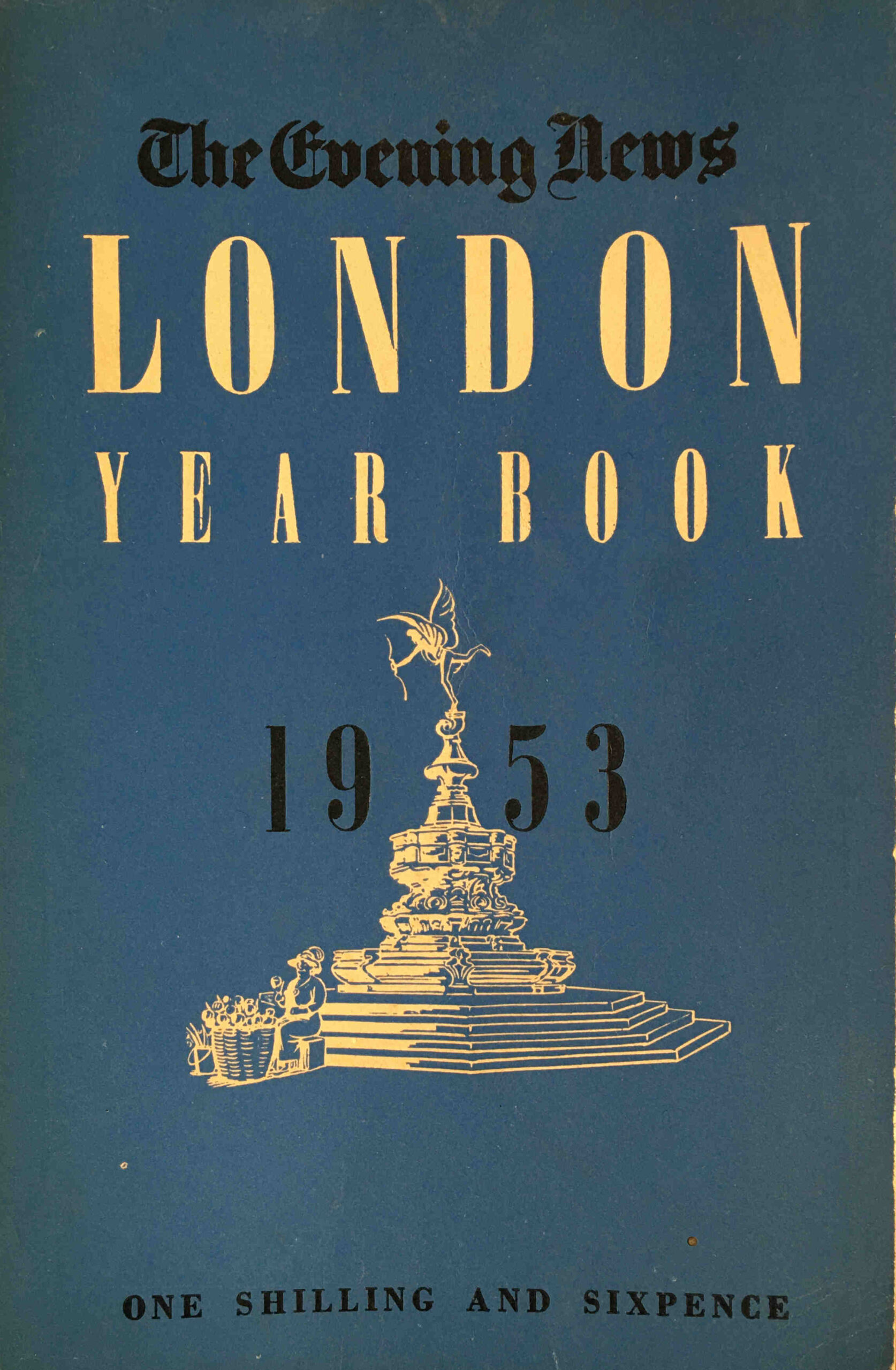
Despite its small size (7 by 4.5 inches), it was packed with information about London. Statistics, stories and facts, then and now photos, lists of events and dates, 192 packed pages on the city. The book claimed to have “10,000 facts and the answers to the many questions on Britain’s capital which are constantly being asked”.
As with 2023, 1953 was also a Coronation year, and in an article looking at the accommodation of Coronation visitors, the following new challenge is identified in estimating the numbers who would visit the city “Circumstances have changed considerably since the last Coronation in 1937. There is an unknown factor in the development of television services, which will take the brilliant panoply of the Coronation procession right into the home.”
Organisers were expecting records to be broken, with more than 150,000 overseas visitors arriving in London for the Coronation. In the same period in 1952, the city had 47,624 visitors from overseas, so 1953 would see at least a trebling in numbers.
As well as the Coronation, there were many other events in London during 1953, and the book included the following London Diary listing with a rather diverse set of events:
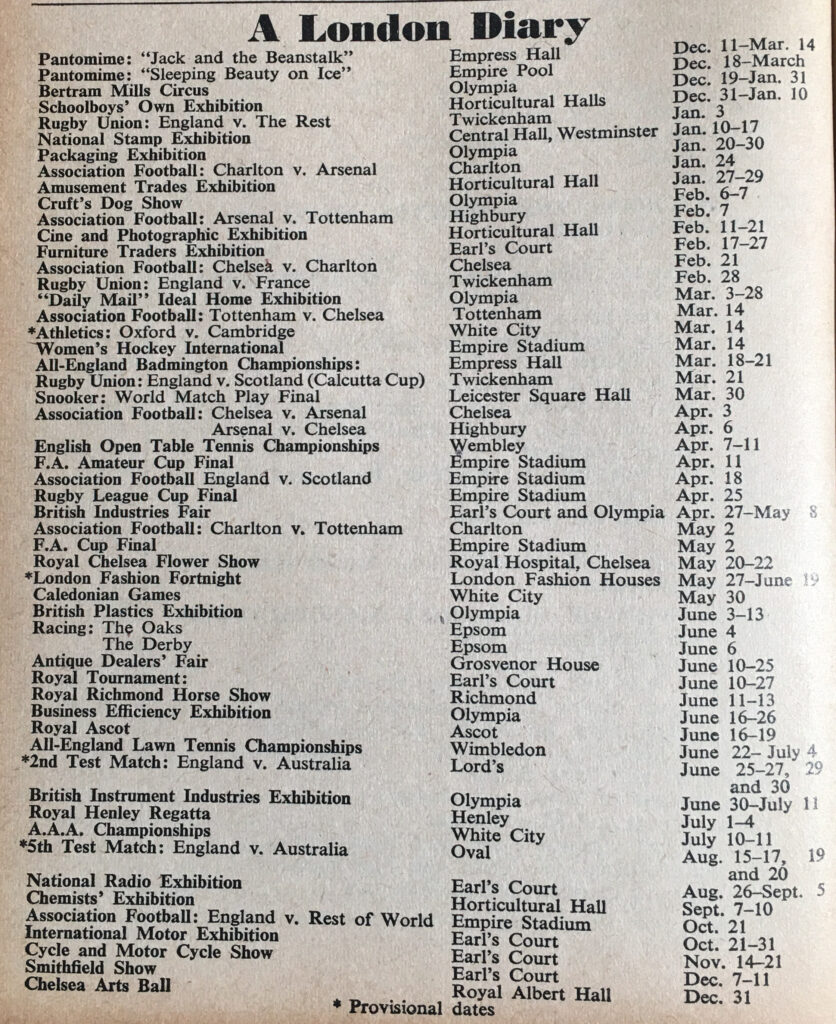
The Empire Stadium and Empire Pool were at Wembley, and the Empress Hall was at Earls Court. The football matches listed are only for teams who were in Division 1 (now the Premier League), so in 1953 London only had four teams, Charlton, Arsenal, Chelsea and Tottenham. Today, all these teams are still in the equivalent of Division1 with the exception of Charlton who are now in Division 1 (which in 1953 would have been Division 3).
The Year Book included a large and diverse range of statistics that show London in 1953, and how the city had changed. One of these was a table of population increases and decreases covering London and the surrounding counties, between 1931 and 1951:
London was a smaller entity in 1953 than it is today, boundary changes in the following years would increase the size of the city and take land from some of the surrounding counties, however the table does show some significant changes.
Between 1931 and 1951 the population of London declined by 1 million people. Much of this was due to wartime damage across London. Large areas of residential streets had been bombed and rebuilding was still to come.
Comparison of London with the surrounding counties shows that whilst the population of London decreased significantly, there were large increases in the surrounding counties. Some of these populations would later be taken back within London (for example parts of Essex and Middlesex), however the table really illustrates the impact the war had on the population of the south east of the country.
Another set of statistics shows the number of people killed or injured on the city’s roads:
The figures in the above table show just how dangerous the city’s streets were seventy years ago. In 1951 a total of 665 people were killed and 40,736 injured. Compare with the latest set of figures from Transport for London, and their “Casualties in Greater London during 2021” data release reports that in 2021, 75 people were killed, 3,505 seriously injured and 23,092 slightly injured – a significant reduction over the past 70 years.
This again is across a wider area than 1951, with a higher population and more traffic on the roads. The TfL data release does consider that COVID may have led to a reduction in traffic, however the figures for 2021 were part of an ongoing reduction in deaths and casualties across the city streets.
The Year Book includes a series of “Then and Now” photos, which illustrated how the city had changed. Along with photos under the heading of “Time Marches On….” which illustrated the many aspects of the city that were changing and developing.
The first compares two methods of global transport, with a photo of the Cutty Sark under tow to a berth in Millwall Docks, following a collision on the Thames with a tanker, in 1952. This is compared with the latest form of global travel with the De Haviland Comet, the world’s first jetliner service taking of from London Airport on a flight to Johannesburg.
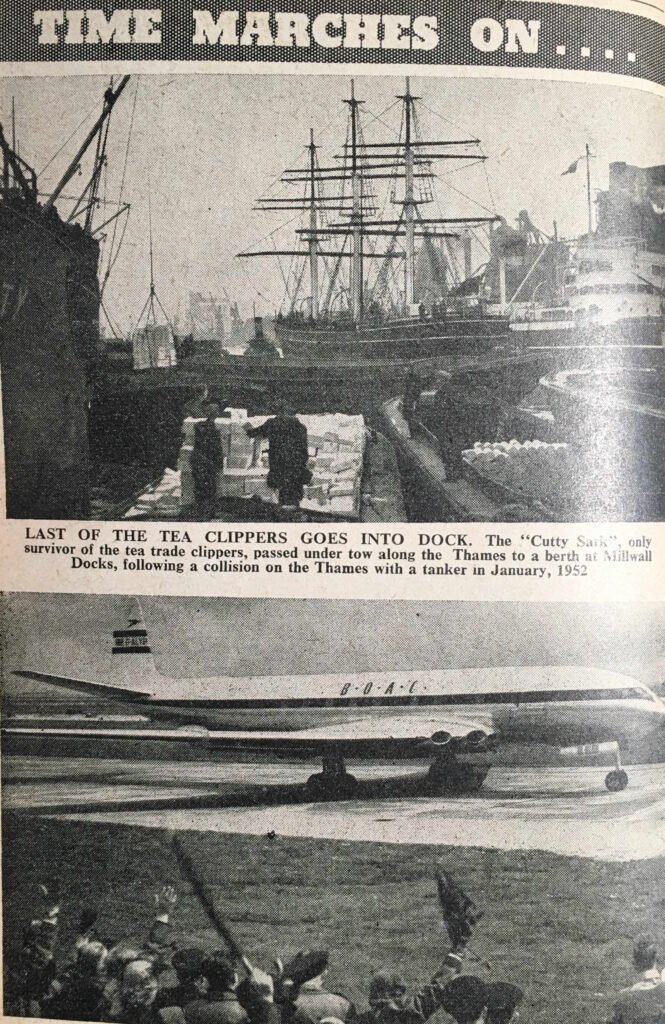
The excitement of the crowds in the bottom of the photo as they wave off the de Havilland Comet would be short lived. The first production release of the Comet suffered a number of fatal crashes. Design problems and structural issues would be identified and would result in redesigned versions of the aircraft, however by the time they were in production, other aircraft companies such as Boeing had jumped ahead.
The aircraft in the above photo with the registration G-ALYP was one of those that crashed. This happened on a flight back to London from Singapore. Soon after taking off from Rome, the aircraft exploded and debris fell into the Mediterranean, killing all 35 people on board.
Another changing form of transport was the London tram, with the last tram on the 5th of July 1952 being featured. My father also took some photos during “Last Tram Week” which are in this post.
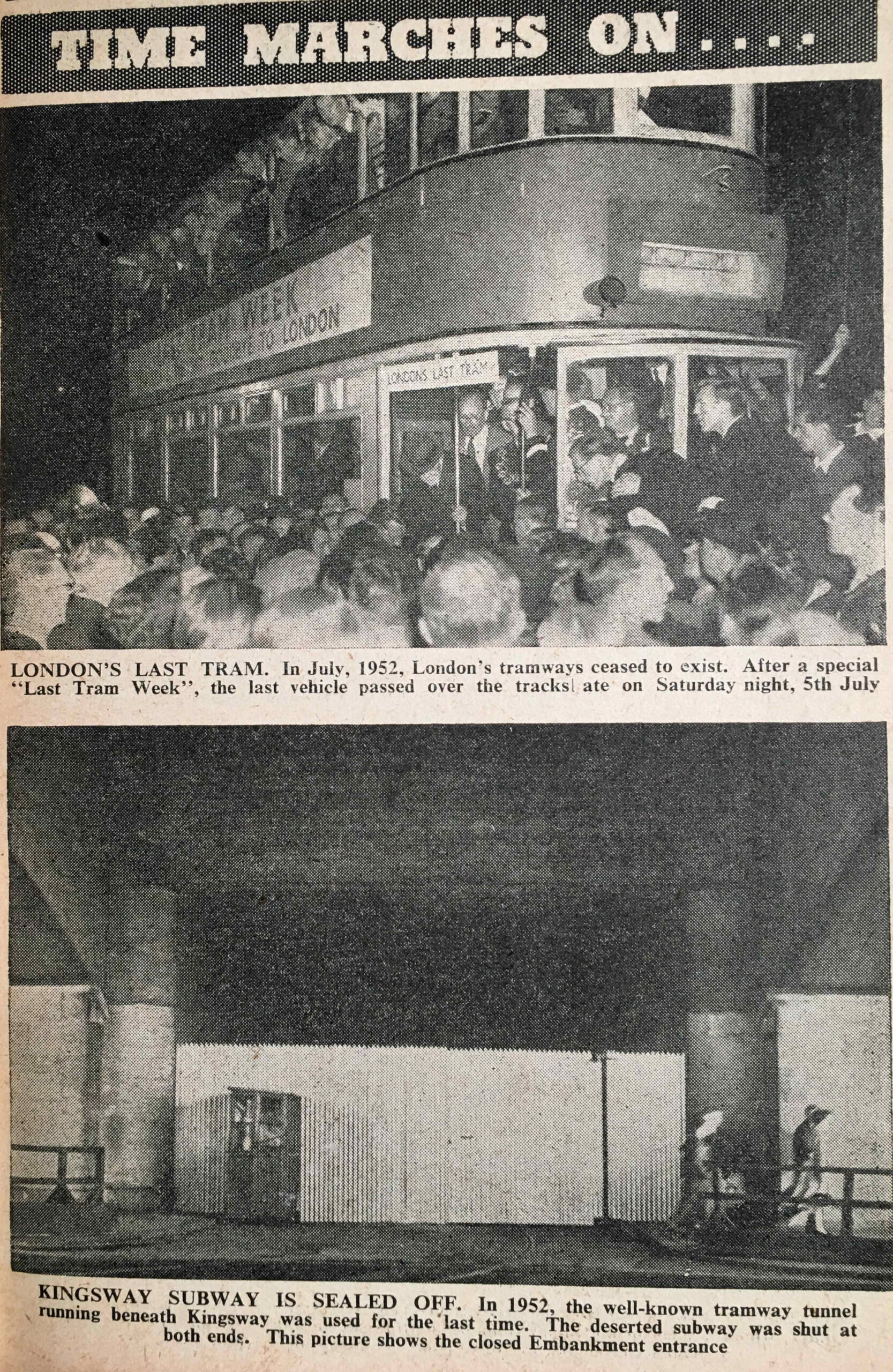
The above photo shows the sealed off entrance from the Embankment to the Kingsway tram subway, which was made redundant following the closure of the tram network.
The majority of the buildings of the Festival of Britain on the Southbank had been demolished by 1953 and the Year Book includes a photo of the site, with the remains of the Dome of Discovery in the background (see this post for photos of the Festival of Britain site before demolition):
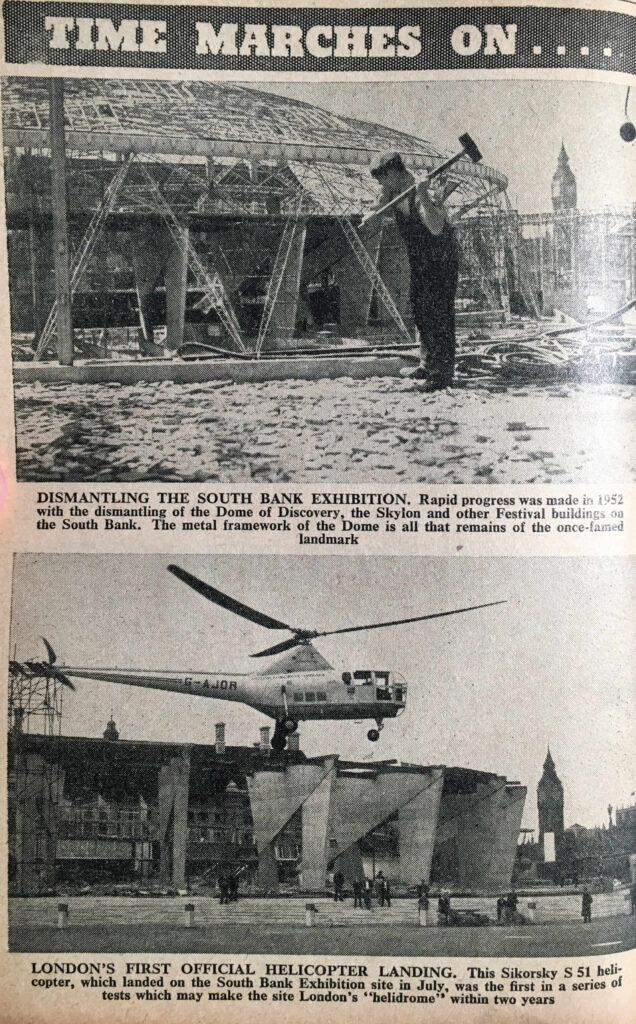
The above photo shows parts of the concrete supports to the Dome of Discovery with County Hall in the background. The focus of the photo is on the helicopter landing on the Southbank site, which was the first of a series of tests to enable the site to become a “helidrome”.
The site did become the Waterloo Air Terminal, offering check-in services and coach travel to Heathrow Airport. There was a limited helicopter service for a period offering faster travel to Heathrow (see this post for more on the Waterloo Air Terminal).
Some photos under the “Time Marches On” theme also showed the repair of wartime damage, as with the Temple Church:

And the above photo shows bricklayers at work on the last 20 feet of the 320 foot chimney of the new Bankside Power Station – from the days when most protective headgear in construction work seemed to consist of a flat cap.
Time Marches On also applied to reconciliation with Germany, as in the following photo of the first time that a “top-flight German athletics team” arrived in London since before the war:

And the above photo highlights the return of one of the many London buildings used by the Government during and after the war.
London Transport
Several pages in the London Year Book were devoted to London Transport, with the following introduction to how London’s public transport system had been organised up to 1953:
“London’s transport system was first united under the name London Passenger Transport Board in July 1933, when 170 different undertakings were taken over, including the Metropolitan Railway, the London County Council Tramways, the Central London Railway, and the London General Omnibus Company.
The first regular London bus services was inaugurated in 1829, when George Shillibeer began a service with a single horse-bus running through the streets of London. In 1856 an Anglo-French company, known as the London general Omnibus Company, began operations, an organisation which grew to become the largest of its kind in the world.
L.P.T.B. ran London’s transport until 1st January 1948, when under nationalisation it became the London Transport Executive.
Today, the London transport area is 1,986 square miles, roughly one twenty-fifth of the whole of England. it covers two counties and parts of seven other counties, as well as serving parts of a tenth county. The estimated population of this area is 9,800,000.”
Part of this extensive network, and one that served the counties around London was the coach service, with Green Line providing timetabled services to places around London, as well as sight-seeing and private hire coaches:

The London Year Book includes the passenger journeys made in 1950:
The Year Book appears to have used the term Railways for the Underground network. For comparison, from the last reporting period, from the London Datastore, comparison figures are:
- Buses: 1,490,700,000
- Underground: 748,300,000
The use of buses shows a considerable drop over 70 years, however the figures come with the caveat that the scope of central buses in 1950 and the bus network today may be very different.
Underground journeys do show an increase of over 100 million, which sounds about right given the enlargement of the underground network over the last 70 years.
The London Year Book includes a number of statistics that show the scale and complexity of the Underground network, including:
- 106 lifts are maintained at 37 stations
- The longest railway station escalator in the world is at Leicester Square Station with a vertical rise of 80.75 feet
- The shortest escalator is at Chancery Lane Station with a vertical rise of 15 feet
- 106 lifts are maintained at 37 stations
- The deepest lift shaft ay 181 feet is at Hampstead Station
- The shortest lift shaft at 30 feet 6 inches is at Chalk Farm Station
- There are 1,150 automatic ticket machines in use which issue 85 per cent of all tickets and use more than 15,000 miles of paper a year
The Year Book identifies a number of “London Transport Records”:
- Highest point on the road is a country bus and coach route at Botley Hill, Warlingham, Surrey
- Deepest point is in the railway tube 67 yards south of Waterloo Station , where the tunnel is 67 feet below ground
- longest continuous tunnel in the world runs from just south of East Finchley Station to Morden Station via Bank on the Northern Line. 17 miles 528 yards in length, it has been in use since 1939
- Longest railway journey direct is from Liverpool Street to Aylesbury at 41.8 miles
- Longest railway journey changing once is from Epping to Aylesbury at 58.8 miles
- Longest Green Line Coach route is the 716 Hitchen to Chertsey at 66 miles
- Shortest bus route for Central buses is the 249 which runs from Upminster Station to Corbets Tay at 1.3 miles
What I did find strange was the statement that the deepest point in the tube network is just south of Waterloo Station, where the tunnel is 67 feet below ground, however in the previous statistics it states that the deepest lift shaft at 181 feet is at Hampstead.
I assume the deepest point just south of Waterloo Station is referring to depth below sea level. Hampstead Station is at a height of 351 feet above sea level, with the area around Waterloo Station at around 3 feet above sea level, so the statement about the tunnel south of Waterloo being the deepest is correct, relative to sea level.
There is a list of the longest bus routes on the network:
- On summer Sundays: 112 from Palmers Green to Hampton Court (22.3 miles)
- On winter Sundays: 59 from West Hampstead to Chipstead Valley (22 miles)
- On weekdays: 25 from Victoria to Hornchurch (19.6 miles)
- On country buses: 414 from West Croydon to Horsham Station (32.6 miles)
The oldest bus route in 1953 was the one running between Shepherds Bush and Liverpool Street Station. It was founded in 1866 and in 1953 was route 11, this number being in use from 1905. Today route 11 runs between Fulham Town Hall and Appold Street where it terminates two stops after Liverpool Street Station.
The change from Shepherds Bush, first to Hammersmith seems to have happened around 1970, then to Fulham around 1994.
The challenge with full comparisons between 1953 and 2023 are the significant changes to the transport network, as well as where and how people liver and travel.
For the underground network, completely new underground lines would be constructed in the decades after 1953. The war had put a hold on expansion of the network, and the Year Book identifies the sections where work had recommenced and been completed:
Back to some of the photos in the book, and under the “Time Marches On….” category, there is a photo of the figure of Justice above the Central Criminal Court / Old Bailey, to highlight the major restoration of the building:
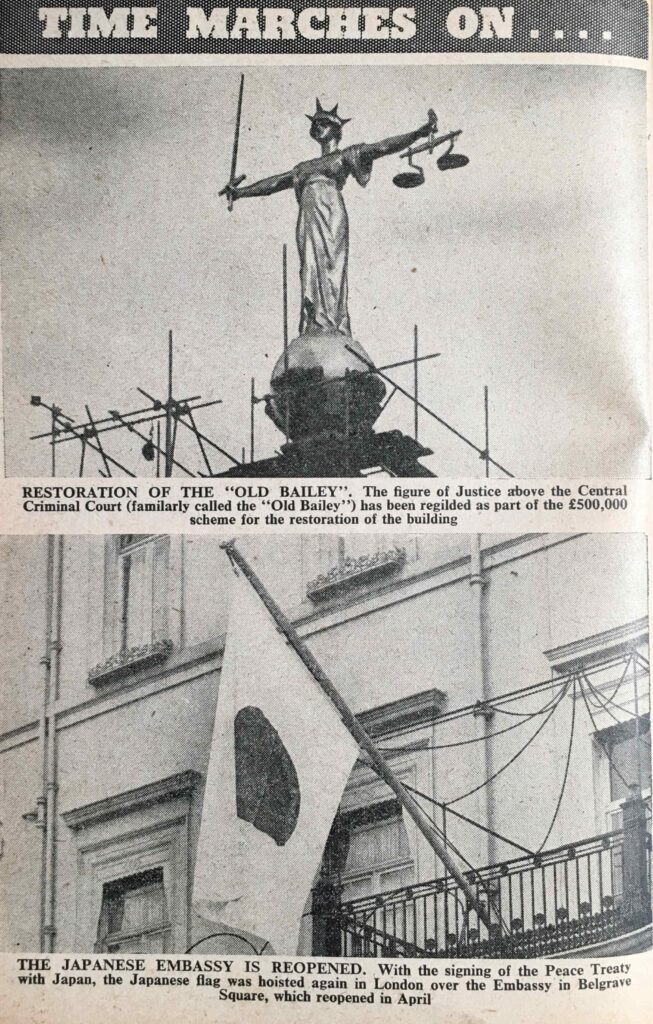
Which is followed by a photo of the Japanese flag in front of the Japanese Embassy, following the signing of the peace treaty with Japan, and the restoration of relations between the two countries.
The following photo shows a Roman coffin discovered during excavations in Furnival Street, Holborn. The years following the war were a time of significant reconstruction in the City, and although much was discovered, I have always wondered how much archaeology was lost.
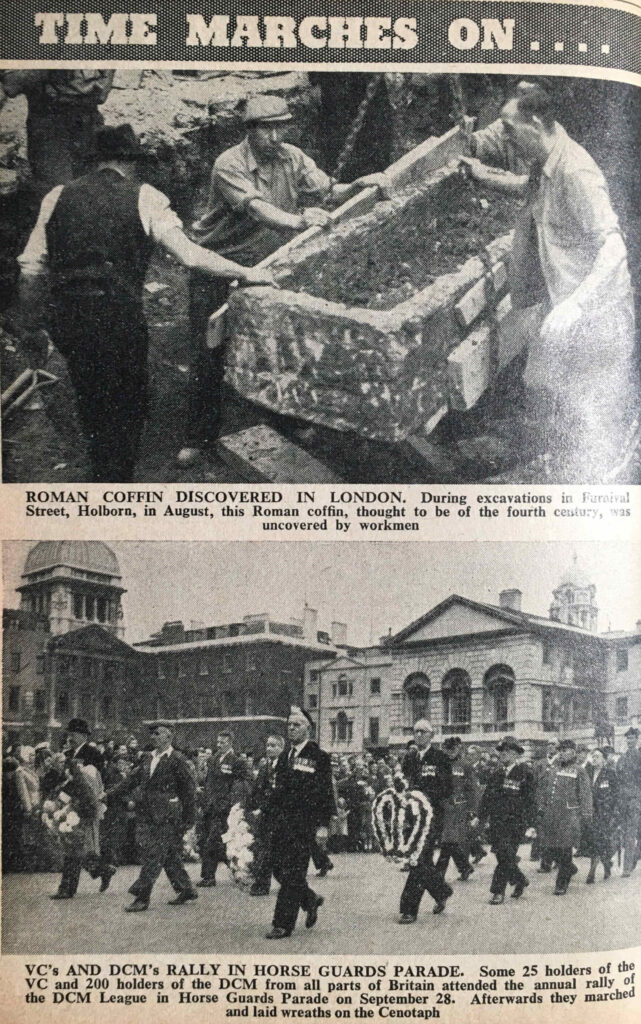
The above photo shows a rally of holders of the Victoria Cross and the Distinguished Conduct Medal in Horse Guards Parade.
The “Then and Now” theme continues with two photos showing Kingsway. In the top photo, taken in 1905, the Kingsway tram subway had just been completed. By the time of the second photo in 1952, the subway had become redundant and the right side of the street had been developed.
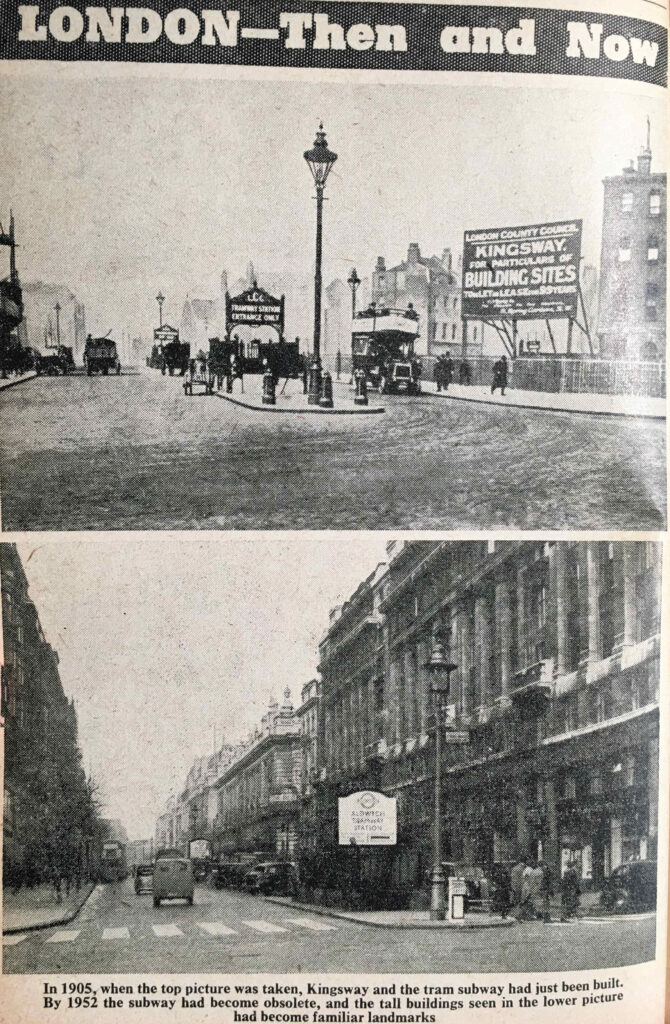
Supplying London with Electricity
The London Year Book includes a few pages on the supply of electricity across London. This was a time when electricity generating stations were operating across London, and the use of coal was one of the major causes of air pollution.
The following table lists the locations of power stations across London, along with their generation capacity in kilowatts:
My grandfather worked in the St. Pancras power station up until 1948.
Note that the Bankside figure is for the original power station on the site, not the power station that was being constructed (see this post on Building Bankside Power Station).
As with the London transport system, the post-war period had seen the consolidation of electricity supply in London, and the Electricity Act of 1947 formed the British Electricity Authority which consisted of fourteen individual electricity boards across the country, with the London Electricity Board serving London.
Bringing together the electricity supply industry was also aimed at standardising electricity supply. The early 1950s was not a time when you could have taken your mobile phone charger (assuming there could have been such a thing), and simply plug it in to any electricity socket in the city.
There were still many non standard electricity supplies, and the Year Book records some figures in the change over of consumers’ supply, with 6,112 consumers having been transferred from Direct Current (DC) supplied to Alternating Current (AC) – the supply type we use today, as well as 1,337 consumers from non-standard to standard AC supplies.
These changes were part of creating the world we take for granted today, where standard electricity supplies resulted in standard appliances, lower costs and easier availbility.
There was still much change to complete however, as the Year Book records there were still 155,998 DC services being provided.
Over the coming decades, all the power stations within London would close down as larger power stations were built along the Thames, out towards the estuary, and London was integrated into the wider country grid. In turn, these stations along the Thames would also close.
Back to “Then and Now”, and two photos showing Marble Arch, the top photo from 1904, and the second showing how the area had been developed by 1953:

Two photos showing Swiss Cottage, showing that the “place has changed surprisingly little during the last sixty years”. The view of Swiss Cottage is a bit different today.
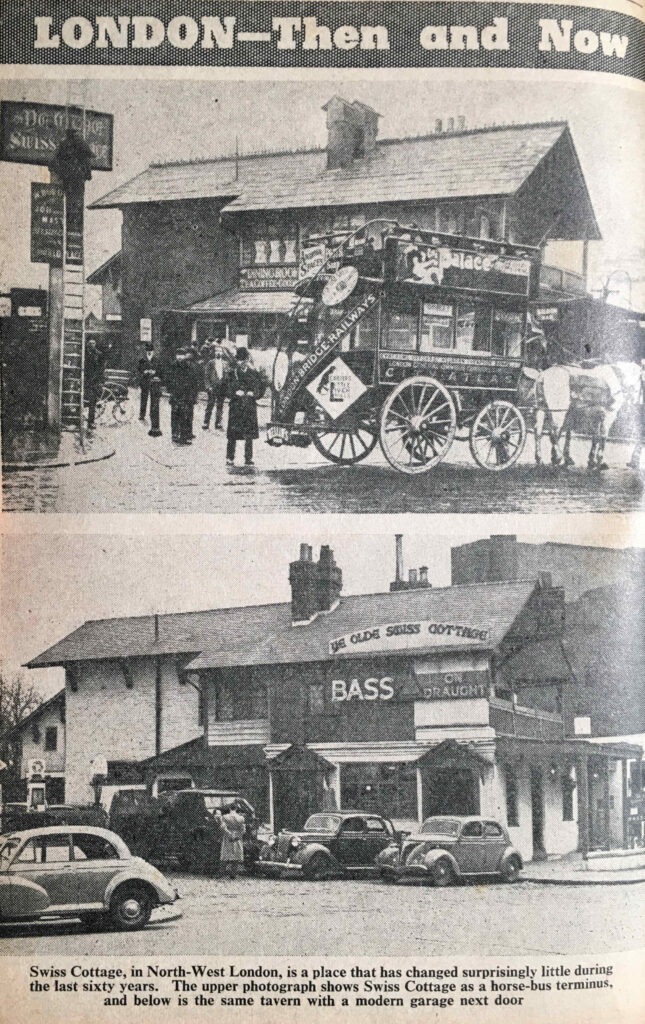
Brompton Road, before and after redevelopment, including the construction of Harrods:
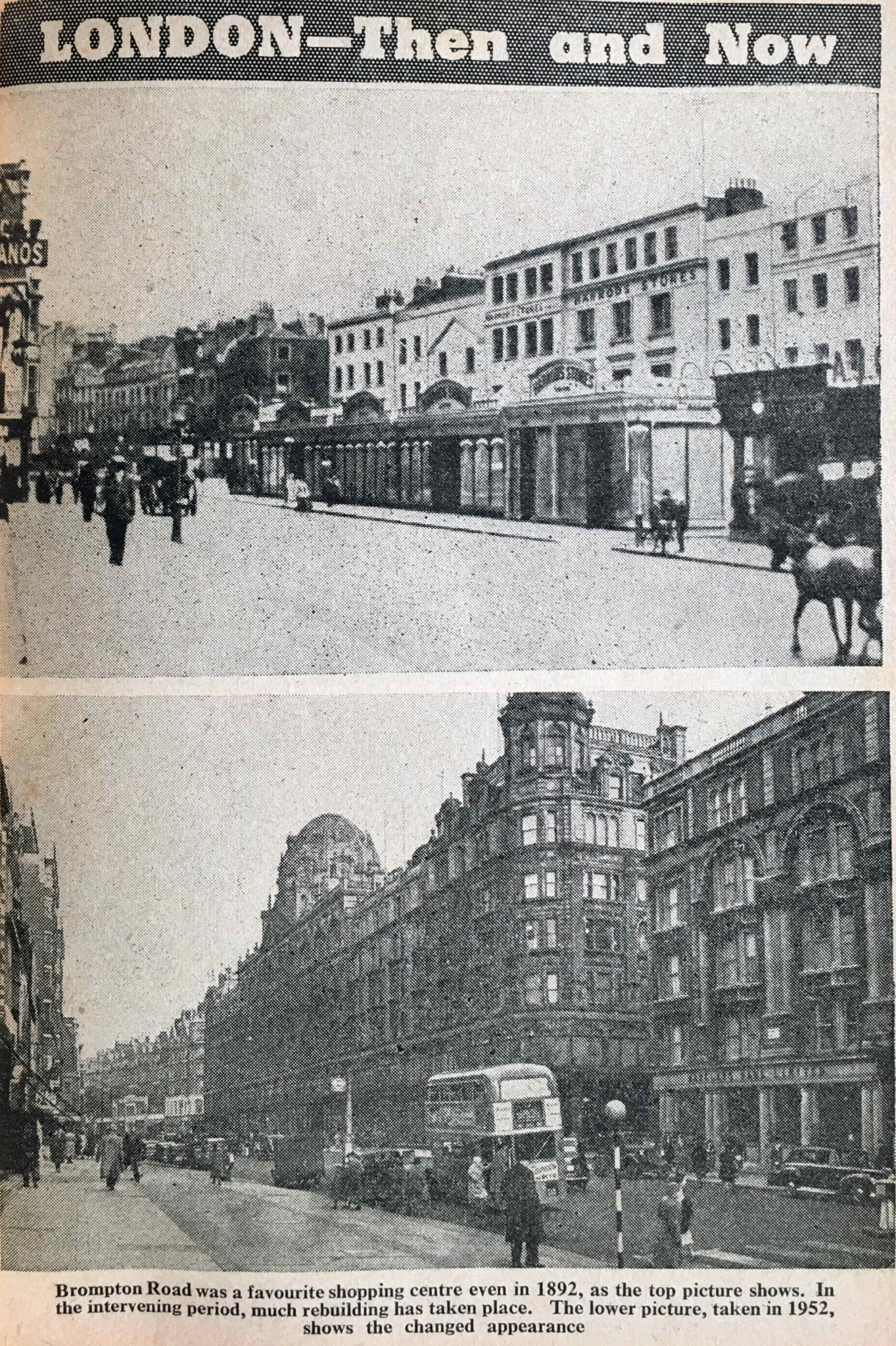
The Post Office and London Telecommunications
Some of the statistics in the London Year Book show numbers and technologies that would change beyond all recognition in the years between 1953 and 2023, for example, in 1953:
- Number of telegrams delivered: 5,885,300
- Number of telephones: 1,755,919
- Number of telephone calls: 1,730,000,000
- International (radio) calls: 249,000
- Telephonists: 16,117
- Number of letters and packets posted: 2,737,394,100
- Letters and packets at Christmas: 83,745,200
- Number of pillar and other post boxes: 11,688
- Number of postmen: 32,195
The telegram has disappeared, there are probably still a high number of telephones, but more mobile phones, with many of the traditional land lines not being used. Although there were sub-sea telephone cables in 1953, radio was still being used to put through international calls, for example from the very tall radio masts that were at Rugby, alongside the M1.
The job of a telephonist is now redundant, and I suspect many of the telephone calls and letters have been replaced by messaging and email applications.
In 1953, the Internet and mobile phone would have been more science fiction than reality.
Many of those telephones would have been installed across the expanding city suburbs, and the following “Then and Now” photo from the London Year Book illustrates how the city had expanded during the first half of the 20th century.
The photo at the top shows the rural area in 1905 that would become Golder’s Green, shown in the lower photo:
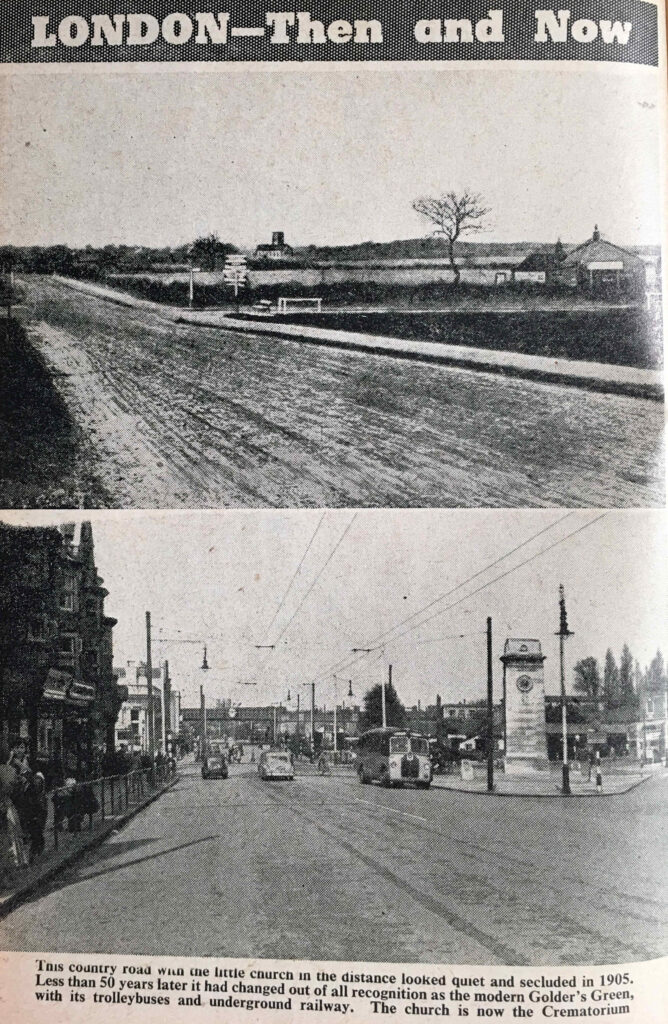
Although London was building and expanding at a rapid pace, there was still a reasonable amount of green space across the city, as listed in the following table, although east London was very poorly provided for compared to the rest of the city:

The Airports of London
The Year Book provides some details on the airports and airlines serving London.
At the time, the London Year Book records that British airliners flew the equivalent of five times around the world every day, and during a year carried over a million passengers.
The heaviest traffic was between London and Paris, with during the summer fifteen flights a day on the route. The longest route served by a London airport was to Tokyo. There were sixteen flights a week to New York.
Three airports serviced London.
The main airport was London Airport, the site that would become Heathrow. In 1953 23 airlines used London Airport, carrying around three quarters of a million passengers in a year. London Airport had “long range radar apparatus, which is able to pick up aircraft flying at more than a hundred miles away”.
The central passenger terminals and tunnel between airport and roads were in the plans, but had yet to be constructed.
Northolt was the second of London’s airports, originally the busiest airport in the country, until being overtaken by London Airport, but in 1953 it was still a busy place, as shown by the following photo of Northolt:
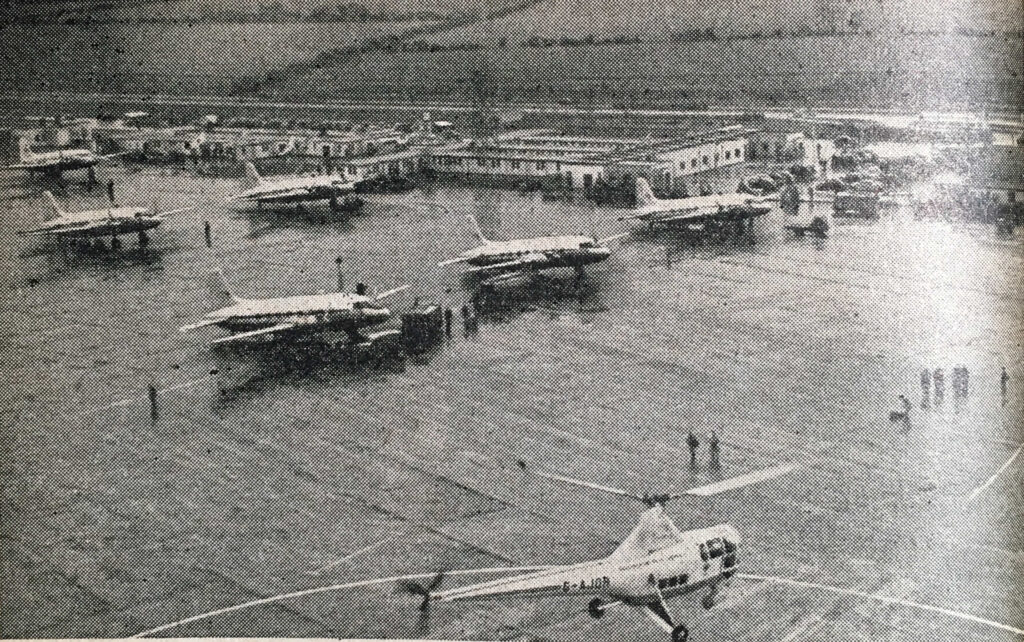
The third London airport was at Croydon, which by 1953 was mainly serving charter aircraft, and handling around 9,000 passengers a year.
Back to central London, and the following photo shows the “basket race”, when market porters ran around a track whilst carrying a large number of baskets on their heads.

The following photo is accompanied by the text “The three London buses which made a 12,000 mile tour of America and Canada are seen in this picture after they had arrived back in Britain in August 1952. Large crowds gathered on Horse Guards Parade for a ‘welcome home’ ceremony.”

I suspect that the buses are the ones that were sent to America and Canada to advertise the Festival of Britain. London buses had also be sent across Europe to advertise the Festival.
I covered earlier the power stations across London that generated electricity for the city. There was a more polluting industry that provided energy for London, and the following photo shows hot coke being guided through a retort at the Beckton Gas Works.
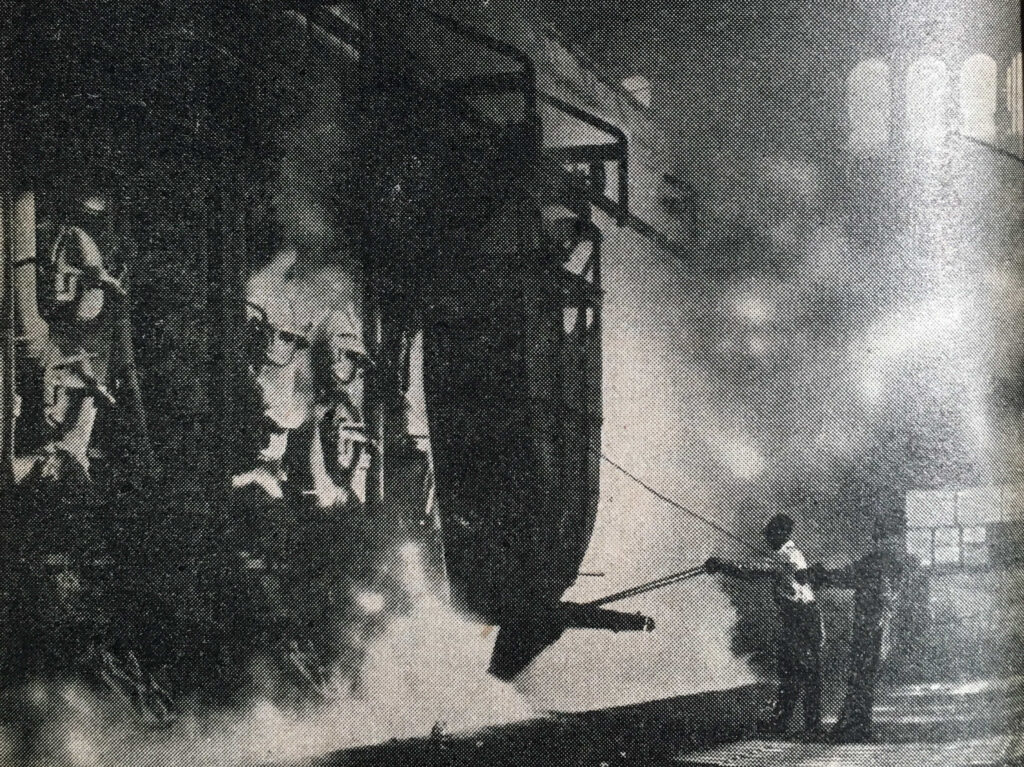
Prior to the discovery of natural gas in the North Sea, gas was produced from coal, an incredibly dirty and polluting process.
As with electricity, the production and distribution of gas had been consolidated into the North Thames Gas Board, that as well as serving London, provided for customers out to Bracknell, High Wycombe and Marlow in the west, and Southend and Shoeburyness in the east.
In the year 1950 to 1951, 367,084,958 therms of gas were sold, with 4,528,789 tons of coal being carbonised to produce the gas.
As well as 1,937,155 tons of coke, this process also produced 227,000 tons of tar, 6,500,000 gallons of Benzole and 111,000,000 gallons of ammoniacal liquor – a highly polluting process.
Crime and Policing
The City of London Police had a strength of 616 officers in 1951. They dealt with a range of crimes, and those classed as larcenies (robbery, theft by a servant, theft of motor vehicle, fraud etc.) totaled 2,506 in 1951.
The following table shows the type and numbers of offences against the person and property:

Motoring offences across London were rising rapidly, probably due to increased car ownership. In 1949 there were a total of 77,326 offences, rising to 89,002 in 1951.
Some other statistics from London policing:
- There were 138,745 registered aliens across Greater London in 1951
- 19,820 firearms certificates were issued during 1951
- There were 8,038 licensed premises in the ‘off’ and ‘on’ trade
- There were 19,727 arrests for drunkenness in 1951
- 404 men and 14 women were charged with begging. 247 men and 134 women were charged with sleeping out
- 1,076 persons were recorded as missing during 1951
- Police rescued 24 people from drowning, however 83 bodies were recovered including that of one child
The early 1950s were a time when the police used the BBC to broadcast messages and appeals, and in 1951, 172 messages were broadcast on behalf of the Metropolitan Police, of which 84 were successful.
The police were probably involved with maintaining order at football games, and one featured in the Year Book shows “Ditchburn pushes the ball off the head of Souden in the Spurs v. Manchester City match at Tottenham on September 1st, 1951” – although according to the 11v11 website, on September 1st 1951, Spurs were playing Newcastle away, with Newcastle winning 7 – 2, so I have no idea which game is captured in the photo.

The London Year Book included a number of adverts, including one showing the story of Arding & Hobbs at Clapham Junction:

The Civil Service Stores in the Strand:
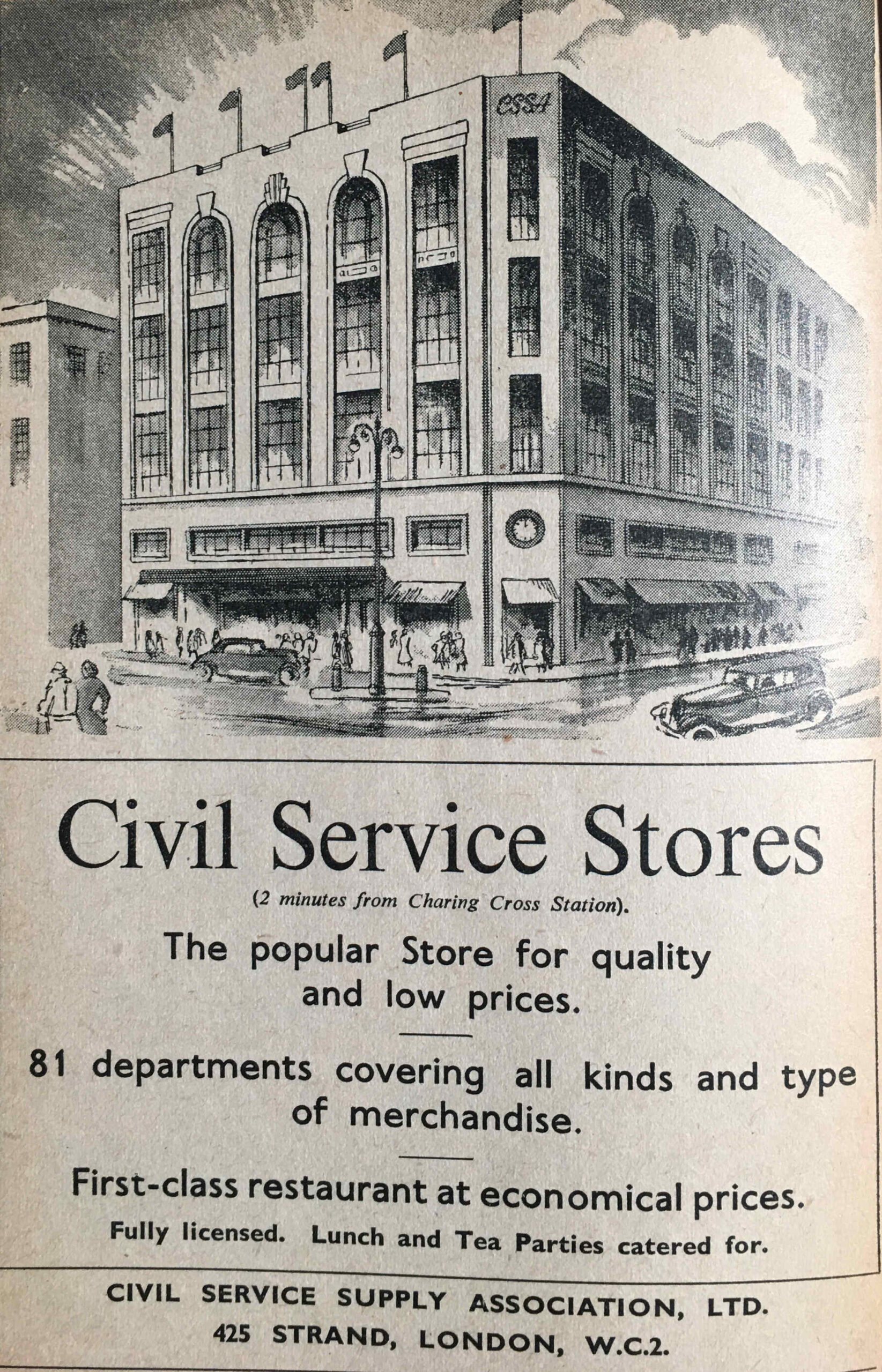
Although the Civil Service Stores as a business closed many years ago, the building can still be seen. It has been modified a number of times, although the clock is still a feature on the corner of the building:
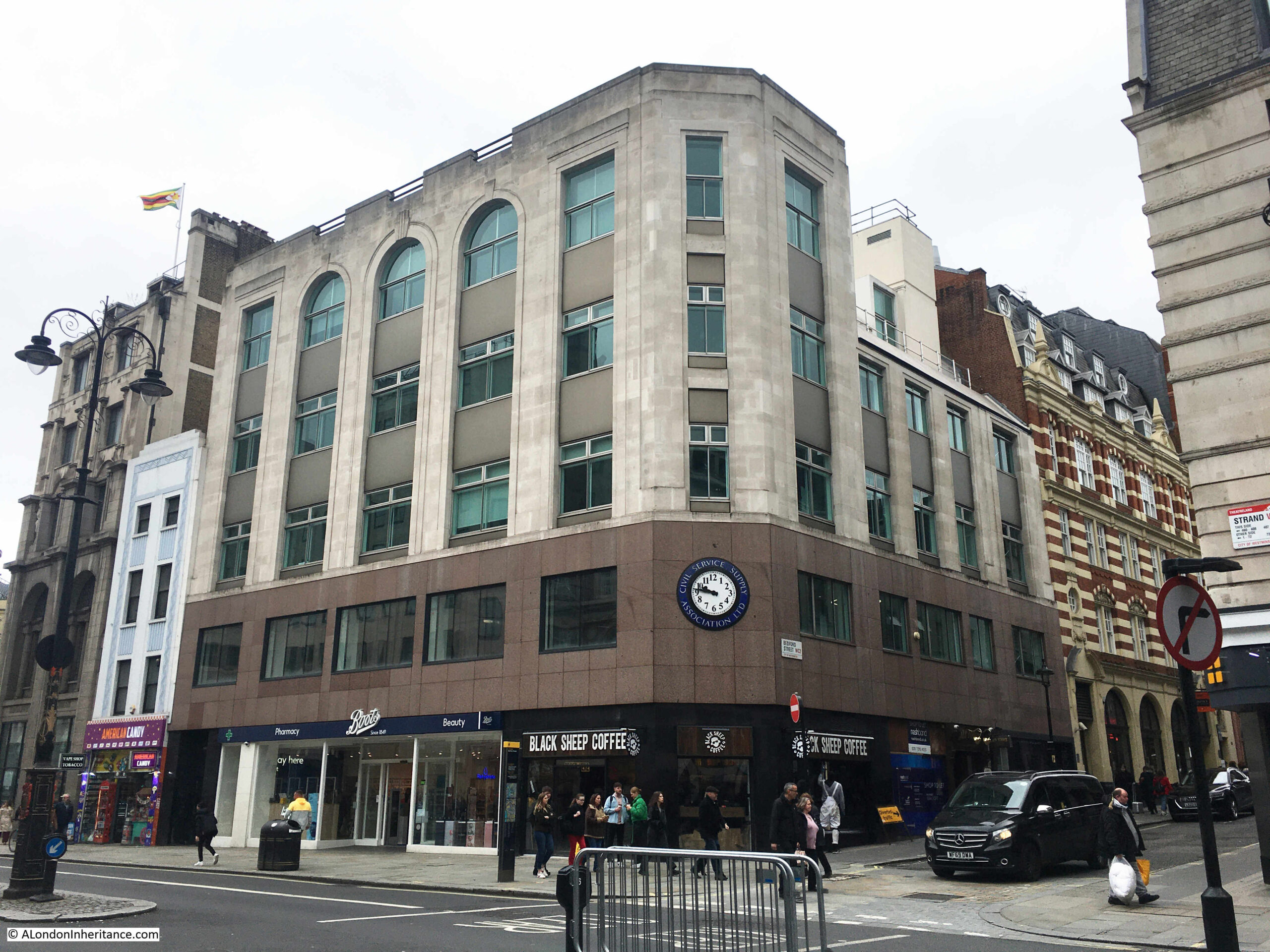
And an advert for London Stadiums Ltd. who ran greyhound racing at Wandsworth, Park Royal and Charlton Stadiums:

The London Year Book covers far more than I have been able to write about in this post. In the introduction, the editor claims that “we think it will help to solve problems and settle arguments, and believe it will prove of real help to everyone living in, or interested in, the world’s greatest city”.
The intention was that the London Year Book would become an annual publication. As far as I know it was only published in 1953 and 1954.
So much of what is covered in the 1953 London Year Book seems like another world, and London certainly has changed considerably in the last 70 years. Reading through the book, it suddenly occurred to me that years I remember really well and are so familiar are actually closer to 1953 than to 2023.
For example, 1983 was only 30 years after 1953, but is now 40 years ago. In 1983, I was in my 4th year of my first full-time job in London, and;
- Blue Monday by New Order, Sweet Dreams by the Eurhythmics and Lets Dance by David Bowie were in the music charts.
- The Falklands War was the previous year, and in June 1983 Margaret Thatcher won a large majority, helped by victory in the Falkland’s.
- ARPANET (the US Advanced Research Projects Agency Network) was configured to use the protocol that would become the Internet, a technology that would transform so much.
- The one pound coin was introduced.
- The comedy series Blackadder was first shown on TV.
- The Campaign for Nuclear Disarmament march in London had over a million people protesting against the deployment of US nuclear cruise missiles in the UK. They would arrive at Greenham Common in November.
- An IRA car bomb killed six people when it exploded outside Harrods.
All the above events were much closer to 1953 than they are to today.
As the title above many of the photos in the London Year Book confirms: “Time Marches On…..”

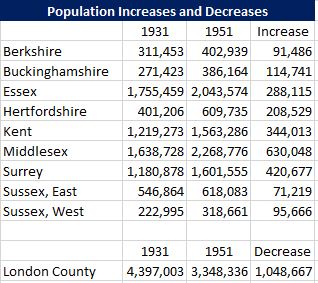
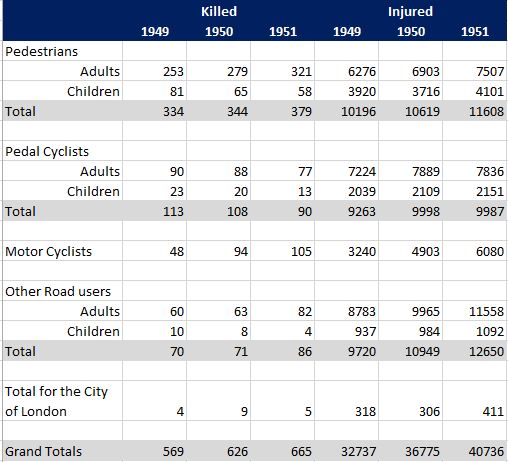

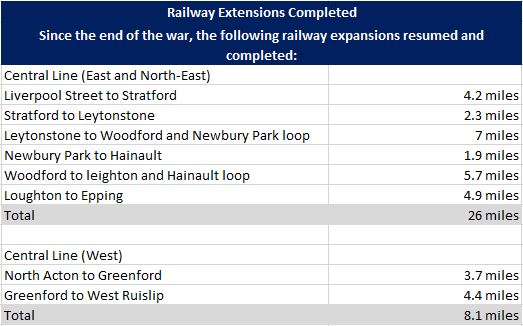

This is not relevant to your post but I am unable to find an email address for you.
I am from Adelaide, formally Stratford E15. My father was born in Northey Street Limehouse in 1926. The pub he was born in “The Red, White and Blue” was demolished. I have been unable to find out when, or a photograph. I wondered with your extensive knowledge of London if you had any idea, or if you had any information you could share.
I very much enjoy your posts and appreciate the time and effort you pit into them.
Being born in bow in 1936 and being a messenger ger boy for the daily express I can remember seeing a lot of those places I. My life thank you for the memories
A most interesting account and, since I was born in SW London in April 1953, very relevant to me! Thank you.
I get up on Sunday mornings with the anticipation of reading the weekly mail. Very grateful!
A Wapping resident
G
This post was the cream on top of all the wonderful posts you have done ! As a Londoner and born in 1949 you covered my entire life. I went to the Festival of Britain ( although too small to remember much), saw the last tram, watched the Coronation on the new tiny TV, loved travelling on the Green Line buses, shopped in Arding and Hobbs, etc, etc – well, this was all an extra special Sunday morning treat from you. Thank you so much. A mammoth task but so worthwhile to all your readers.
Like you, I remember so many of the landmarks, but missed both the Festival of Britain and the Coronation!
Brilliant post, thank you so much for taking the time to publish this record of my city…1953 I was thirteen and living in Battersea…..having been born in Camberwell….
I was born in Battersea, grew up in Wandsworth and matured in Merton…
Thanks again for another very interesting post.
Regarding the photo of the football match at Tottenham, I see from the site you linked to that Spurs played Manchester City on 1st September 1952. Also Billy Sowden (not Souden as printed in the book) played for Manchester City. So I think these are typing errors.
looks absolutely wonderful. I will enjoy reading it from cover to cover later on today. Many thanks
Fascinating. I first went to work in London in 1970 (as a Civil Servant). The Civil Service Stores were certainly still in business then. Lovely, traditional department store. Bought my first tea caddy from them – still a treasured possession!
Thanks so much for this : what a feast of nostalgia !
The trams were before my time but when was the last trolley bus ?
I remember the Green Line buses and taking ‘exotic’ trips from north London out to the high light of a Half Way house pub/ cafe at High Wycombe with my granddad.
Anyone else remember the Mystery Tour coach trips from Victoria coach station in the 60s ? The destination was undisclosed to the day tripping passengers. Oh the excitement !
Last trolleybus in London ran on the 8th of May 1962.
The decline in Central London population and increase in the surrounding counties from 1931 was perhaps more to do with the building of hundreds of thousands of suburban houses than the effect of WWII ?
Another fascinating post – thank you. Those of us who live nearby wait to see what will become of the Arding & Hobbs building!
It’s still possible to send a telegram as my sister sent one last October as she was unable to attend my younger son’s wedding. The wedding couple and guests were astonished as everyone like you thought the telegram was dead.
Have managed to find a 1954 version of the Year Book which will make a nice gift for a significant birthday next year!
Thanks for a look back at London in 1953. Some of my earliest memories (turning age 3) began when I, and my family, arrived in London in 1953–after a voyage across the Pond on the S.S. United States–docking in Southampton. A return home for my mother…a British war bride–she served as a driver with the St John’s ambulance service throughout the war. We spent most of the decade, and then some, living in and around London before moving to Germany for three years and then returning to the U.S. in the mid 1960s. London always feels like home to me. Happily, I’ll be back again next week.